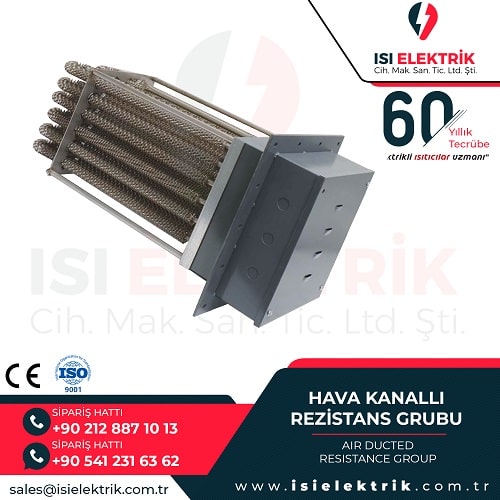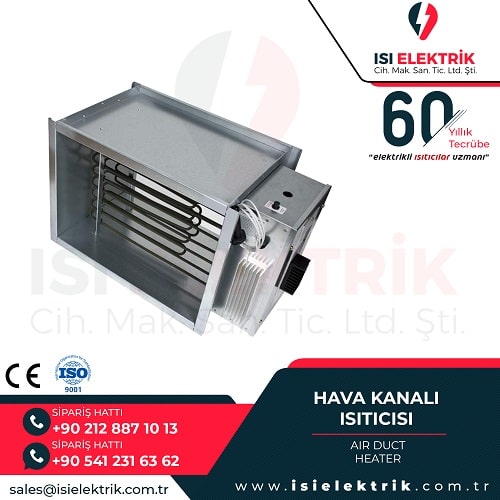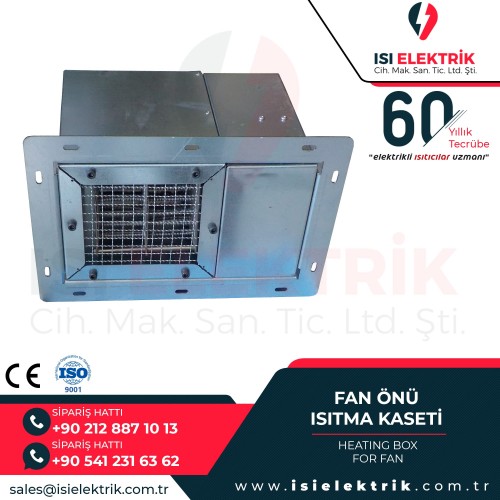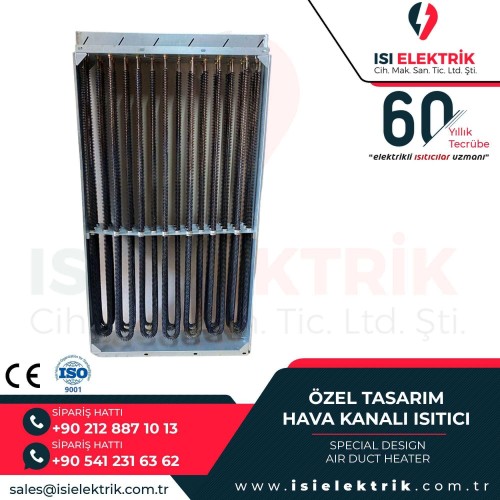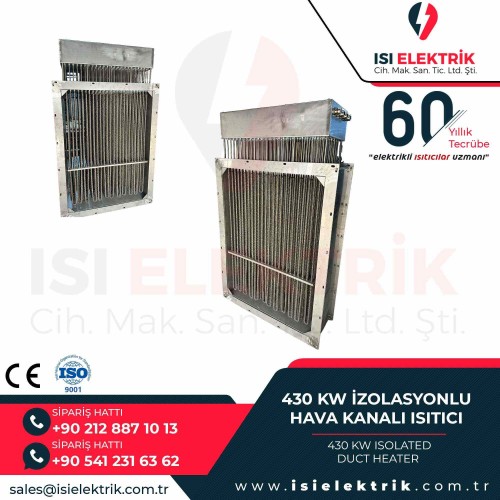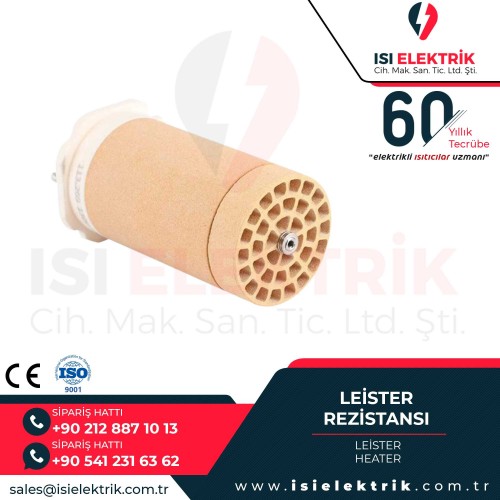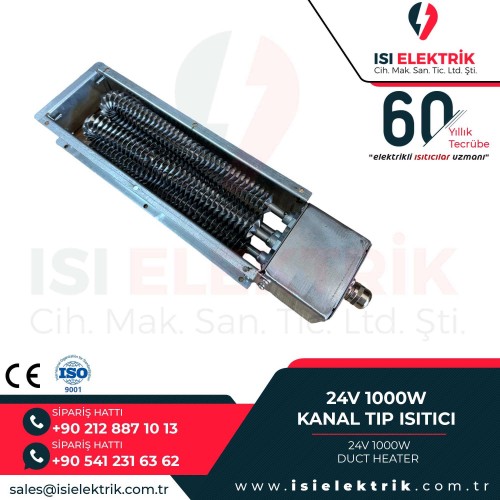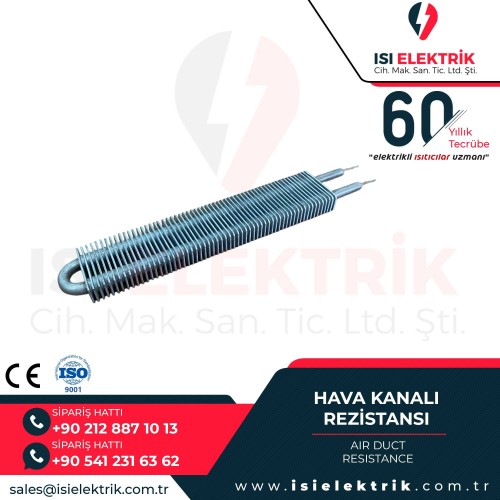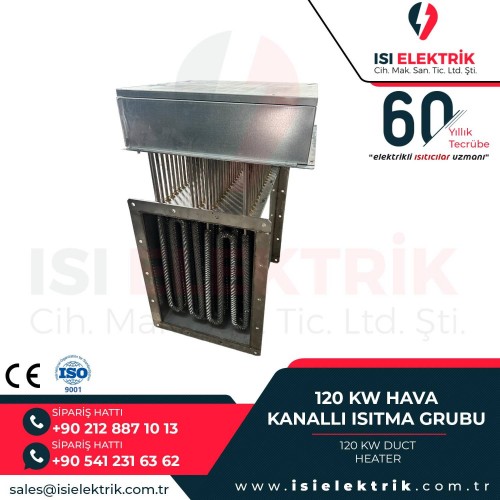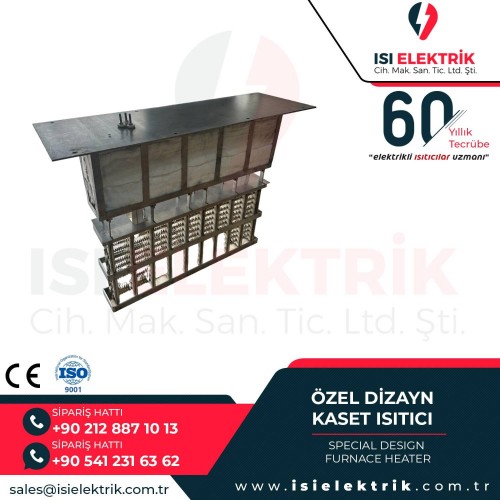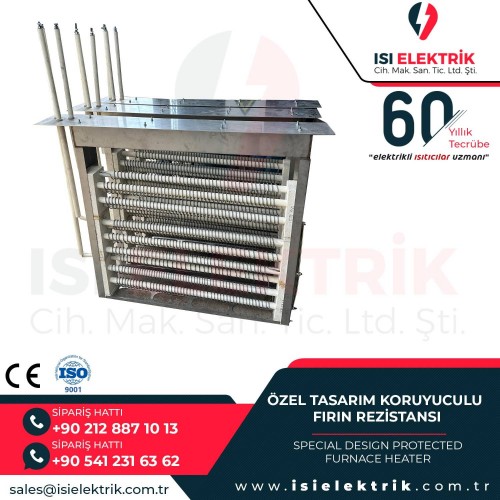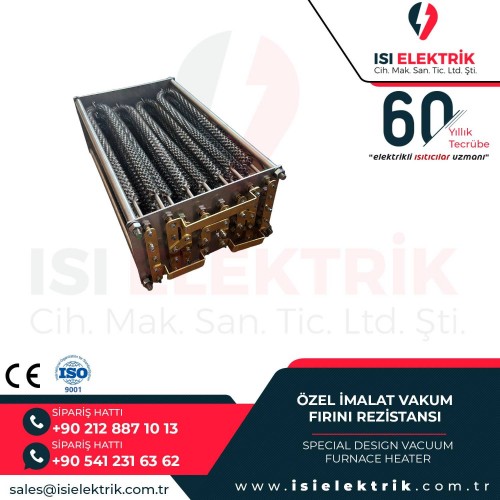Air Duct Heaters
Air duct heaters are essential components in central heating systems that are used to efficiently heat air and distribute it to rooms in large spaces. These heaters are commonly used in large buildings, commercial premises, industrial facilities, and office complexes. The primary function of these heaters is to heat the air and then distribute it throughout the building or specific areas, ensuring a uniform heating distribution in the indoor environment.
The basic principle of operation of air duct heaters involves the transfer of heat from hot water or steam, produced by a central heating system or boiler, to the air through a heat exchanger or heating coil. These heaters are typically installed within a large air duct system, and heated air is then directed to specific rooms or areas within the building. The warm air is quickly and effectively transported through the air ducts, thereby controlling the temperature within the indoor environment.
One of the primary advantages of air duct heaters is their focus on energy efficiency. The hot water or steam is typically produced by a central boiler or heat pump, and the temperature can be adjusted based on the system’s needs. This capability helps achieve energy savings and reduce operating costs. Additionally, these systems not only heat the air but also help to keep cold air out, ensuring that the indoor temperature remains stable. As a result, users can enjoy a comfortable environment with both heating and air circulation.
The design of air duct heaters can vary depending on their intended use. Some models may feature multiple heating coils or large heat exchanger surfaces to provide more efficient heating. This is especially beneficial for high-volume spaces, as it improves overall performance. Furthermore, some systems include automatic control mechanisms that allow users to digitally adjust the temperature, making the system more intelligent. To ensure the system operates efficiently, regular maintenance and cleaning are necessary, which also prolongs the system's lifespan and enhances energy efficiency.
Other benefits of air duct heaters include quick heating times, easy integration, and low maintenance requirements. These heaters are generally long-lasting, made from durable materials that ensure extended service life, increasing the safety of the users over time. Especially in industrial or commercial settings, they provide an ideal solution for evenly heating large spaces while improving indoor air quality. These systems can not only heat the air but also maintain a consistent temperature and quality of air throughout the building.
Air duct heaters play a significant role in modern buildings, offices, factories, and commercial spaces due to their energy efficiency, low operational costs, long-lasting designs, and effective heating capabilities. More and more buildings are turning to these systems for enhanced energy efficiency and comfort. These devices provide not only heating but also improve air circulation and overall environmental quality in the spaces they serve.
Types of Air Duct Heaters
Air duct heaters are designed to meet the heating needs of various environments by utilizing different energy sources and technologies. They are available in different types based on functionality, energy efficiency, and areas of use. Below is a detailed explanation of these heater types:
-
Electric Air Duct Heaters:
These types of heaters operate using electrical energy. They heat the airflow through electric resistors or heating coils. The advantages of electric air duct heaters include:
- They are environmentally friendly as they do not use gas or liquid fuels.
- Installation and maintenance are quite easy.
- They are ideal for enclosed spaces such as homes, offices, and small commercial areas.
- They provide rapid heating and can quickly reach the desired temperature.
However, in regions where electricity costs are high, operating expenses may increase.
-
Gas-Powered Air Duct Heaters:
These heaters operate using fuels like natural gas or propane and are highly effective in heating large spaces. The features of gas-powered heaters include:
- They have high heating capacity and are suitable for large areas.
- They are connected to a burner via gas pipes, effectively heating the airflow.
- They are commonly used in industrial facilities, factories, and warehouses.
- Energy costs may be lower compared to electric models.
However, they cannot be used in areas without a gas line infrastructure.
-
Liquid Fuel-Powered Air Duct Heaters:
These heaters operate using liquid fuels such as diesel or oil and are often preferred for applications requiring high heating capacity. The advantages of liquid fuel-powered air duct heaters are:
- They offer mobility, as fuel tanks can be portable.
- They are suitable for industrial facilities, construction sites, and outdoor events.
- They have very high heating capacities and can operate in challenging environmental conditions.
However, fuel supply and storage requirements can increase the cost and logistics of these systems.
-
Steam-Powered Air Duct Heaters:
These systems are commonly used in large industrial facilities and central heating systems. The main working principle is to heat the airflow using steam from a boiler or steam generator. The advantages of these systems include:
- They provide high efficiency and are effective for heating large volumes.
- They can be integrated into central heating systems, offering energy savings.
- They provide a suitable solution for industrial processes.
Steam-powered systems are typically preferred for larger-scale projects due to their high installation costs and complex maintenance requirements.
-
Heat Pump-Powered Air Duct Heaters:
As a modern technology, heat pump-powered air duct heaters are highly advantageous in terms of energy efficiency. Their working principle is based on transferring heat from outside to the indoor environment. Their features include:
- They save energy and have low operating costs.
- They can offer both heating and cooling functions.
- They are frequently used in homes, offices, and energy-efficient projects.
- They reduce carbon emissions, providing an environmentally friendly solution.
Although heat pump systems have high initial installation costs, they save energy in the long term.
Air duct heaters offer different advantages and disadvantages based on their areas of use and energy sources. Therefore, it is important to consider your needs and existing infrastructure to make the right choice.
Heaters Used in Air Duct Resistors
- Coil Heaters:
- Construction and Design: Coil heaters are notable for their tubular structure. They typically contain heating elements within coiled metal tubes.
- Applications: Coil resistors working with water or steam are used to transfer and carry hot water or steam in heating systems.
- Heat Transfer: The hot water or steam circulating inside the tubes facilitates heat transfer to the surrounding air or other fluids.
- Control and Regulation: Coil resistors employ thermostats or control valves for temperature regulation.
- Tubular Heaters:
- Construction and Design: Tubular heaters consist of a metal tube and a heating element passing through it. The heating element is typically made of nickel-chromium alloy or stainless steel.
- Applications: Tubular heaters find applications in air duct heaters, furnaces, industrial heating systems, and various other applications.
- Heat Transfer: Heat transfer in tubular heaters occurs through the walls of the tube to the surrounding air or fluid.
- Control and Regulation: Temperature control in tubular heaters is achieved using thermostats or controllers.
Air Duct Heaters Resistors Technical Specifications
- Type:
- Serpentine Resistors: Heating elements are found inside metal tubes in a pipe shape. They operate with water or steam.
- Tubular Resistors: Consist of a metal tube and a heating element passing through it. They operate with electricity.
- Power:
- For Small Homes: 2-5 kW
- For Medium-sized Homes: 5-10 kW
- For Large Homes: 10-15 kW
- For Commercial Buildings: 15 kW and above
- Voltage:
- Single Phase: 220V
- Three Phase: 380V
- Current:
- For 2 kW Heaters: 9A
- For 5 kW Heaters: 23A
- For 10 kW Heaters: 46A
- Efficiency:
- Electric Air Duct Heaters: %90-95
- Gas-Powered Air Duct Heaters: %80-85
- Liquid-Fueled Air Duct Heaters: %75-80
- Heat Transfer:
- In Serpentine Resistors: Hot water or steam circulating inside the tubes enables heat transfer to the surrounding air by contacting the tubes' exteriors.
- In Tubular Resistors: Heat transfer to the air occurs from the walls of the tube.
Advantages of Air Duct Heaters Resistors
- Quick Heating: Resistors can heat the air very quickly, which is ideal for rapidly heating buildings and other structures.
- High Efficiency: Resistors operate with very high efficiency, allowing you to save energy and reduce heating bills.
- Uniform Heating: Resistors can heat the air evenly, preventing temperature differences in buildings and other structures.
- Easy Control: Resistors can be controlled very easily, allowing you to adjust the temperature of the heating system exactly as you desire.
- Safety: Resistors operate very safely, with no risk of fire or explosion.
- Long Lifespan: Resistors have a very long lifespan, allowing you to use them for many years.
- Easy Maintenance: Resistors can be maintained very easily, ensuring that your heating system operates smoothly.
Air Duct Heaters Resistors Usage Areas
- Factories and Manufacturing Facilities: Industrial facilities use air duct heaters to heat production lines or warehouses. Maintaining specific temperature conditions is crucial in these facilities during the production process.
- Large Commercial Buildings and Shopping Centers: Large commercial buildings, office complexes, and shopping malls commonly utilize air duct heaters. They provide an efficient and effective solution for heating the vast spaces of such buildings.
- Hospitals and Healthcare Facilities: Hospitals and healthcare facilities must maintain appropriate temperature conditions to ensure patient comfort and create a sterile environment. Therefore, air duct heaters are frequently used in such facilities.
- Sports and Recreation Facilities: Gyms, swimming pools, and other recreational facilities often use air duct heaters. Controlling the temperature in these facilities is crucial for user comfort.
- Food Processing and Storage Facilities: Food processing and storage facilities require specific temperature conditions for storing and processing products. Air duct heaters can be used to maintain temperature control in these facilities.
- Hotels and Residential Buildings: Large hotels and residential buildings may use air duct heaters to ensure guest comfort. Central heating systems are often preferred in such buildings, with air duct heaters being a part of these systems.
Types of Air Duct Heaters
Air duct heaters are designed to meet the heating needs of various environments by utilizing different energy sources and technologies. They are available in different types based on functionality, energy efficiency, and areas of use. Below is a detailed explanation of these heater types:
-
Electric Air Duct Heaters:
These types of heaters operate using electrical energy. They heat the airflow through electric resistors or heating coils. The advantages of electric air duct heaters include:
- They are environmentally friendly as they do not use gas or liquid fuels.
- Installation and maintenance are quite easy.
- They are ideal for enclosed spaces such as homes, offices, and small commercial areas.
- They provide rapid heating and can quickly reach the desired temperature.
However, in regions where electricity costs are high, operating expenses may increase.
-
Gas-Powered Air Duct Heaters:
These heaters operate using fuels like natural gas or propane and are highly effective in heating large spaces. The features of gas-powered heaters include:
- They have high heating capacity and are suitable for large areas.
- They are connected to a burner via gas pipes, effectively heating the airflow.
- They are commonly used in industrial facilities, factories, and warehouses.
- Energy costs may be lower compared to electric models.
However, they cannot be used in areas without a gas line infrastructure.
-
Liquid Fuel-Powered Air Duct Heaters:
These heaters operate using liquid fuels such as diesel or oil and are often preferred for applications requiring high heating capacity. The advantages of liquid fuel-powered air duct heaters are:
- They offer mobility, as fuel tanks can be portable.
- They are suitable for industrial facilities, construction sites, and outdoor events.
- They have very high heating capacities and can operate in challenging environmental conditions.
However, fuel supply and storage requirements can increase the cost and logistics of these systems.
-
Steam-Powered Air Duct Heaters:
These systems are commonly used in large industrial facilities and central heating systems. The main working principle is to heat the airflow using steam from a boiler or steam generator. The advantages of these systems include:
- They provide high efficiency and are effective for heating large volumes.
- They can be integrated into central heating systems, offering energy savings.
- They provide a suitable solution for industrial processes.
Steam-powered systems are typically preferred for larger-scale projects due to their high installation costs and complex maintenance requirements.
-
Heat Pump-Powered Air Duct Heaters:
As a modern technology, heat pump-powered air duct heaters are highly advantageous in terms of energy efficiency. Their working principle is based on transferring heat from outside to the indoor environment. Their features include:
- They save energy and have low operating costs.
- They can offer both heating and cooling functions.
- They are frequently used in homes, offices, and energy-efficient projects.
- They reduce carbon emissions, providing an environmentally friendly solution.
Although heat pump systems have high initial installation costs, they save energy in the long term.
Air duct heaters offer different advantages and disadvantages based on their areas of use and energy sources. Therefore, it is important to consider your needs and existing infrastructure to make the right choice.
Technical Details of Air Duct Heaters
- Heating Capacity: The heating capacity of air duct heaters is typically measured in BTU (British Thermal Unit) or kW (kilowatt). Selecting the appropriate capacity is crucial for efficient heating. Factors such as room size, insulation level, and climate conditions should be considered during the selection process.
- Material Structure: The materials used in the construction of air duct heaters play a significant role in their durability and heat transfer performance. Stainless steel and aluminum, known for their corrosion resistance, ensure long-lasting use. Some models also feature extra-insulated surfaces to minimize energy loss.
- Control Systems: Air duct heaters can operate with manual or automated control systems. Advanced models include temperature adjustment, scheduling functions, and remote control options. Automation systems help save energy while enhancing user comfort.
- Safety Features: Modern air duct heaters are equipped with various safety mechanisms to meet safety standards. Overheat protection, automatic shut-off systems, and fault warning mechanisms ensure user safety. Additionally, some models feature special designs to reduce fire risks.
- Energy Efficiency: Energy efficiency is a critical factor in reducing both environmental impact and operational costs. Energy-efficient heaters provide the same heating performance with lower energy consumption. Additionally, some models are compatible with renewable energy sources.
- Installation and Maintenance: Proper installation of air duct heaters is essential for their efficient and safe operation. Along with professional installation, regular maintenance extends the device's lifespan. Maintenance tasks such as filter cleaning, checking electrical connections, and general performance evaluations should not be neglected.
- Noise Level: The noise level of air duct heaters during operation is important, especially for offices, residential spaces, or quiet environments. Low-noise models provide a more comfortable user experience and prevent noise pollution.
- Applications: Air duct heaters are versatile and can be used in a wide range of settings, from residential buildings to commercial facilities, industrial plants, and hotels. Different models are available to meet the specific needs of each environment.
Achieving Energy Efficiency with Air Duct Heaters
- Choosing Energy-Efficient Models: Selecting air duct heaters with high energy efficiency ensures maximum heating performance with minimal energy consumption. High-efficiency models, such as those with advanced energy ratings, significantly reduce operating costs in the long term.
- Automation and Scheduling Systems: Automation and scheduling systems play a crucial role in energy saving. Automatic temperature control ensures the heater operates only when needed. Additionally, remote control features prevent unnecessary energy consumption while maintaining comfort and convenience.
- Insulation and Sealing: Proper insulation and sealing of air ducts minimize energy loss. Poor insulation leads to heat loss, increasing energy usage. Therefore, high-quality insulation materials should be used during the installation of air duct systems.
- Using Thermostats: Smart thermostats are effective tools for enhancing the energy efficiency of air duct heaters. These devices detect ambient temperature and activate the heater only when necessary, preventing energy waste. Programmable thermostats allow users to schedule heating times for additional savings.
- Regular Maintenance and Cleaning: Routine cleaning and maintenance of air duct heaters improve energy efficiency. Dirty filters and clogged ducts force the heater to work harder, consuming more energy. Regular filter replacement and system checks are essential to ensure optimal performance.
- Proper Capacity Selection: Choosing an air duct heater with the right capacity for the space prevents unnecessary energy consumption. An oversized unit wastes energy, while an undersized unit may run continuously to meet the demand, increasing energy use.
- Utilizing Renewable Energy Sources: Air duct heaters compatible with renewable energy sources, such as solar panels, reduce energy costs and provide an eco-friendly solution. Using such systems offers both environmental and economic benefits.
- Optimizing Airflow: Optimizing airflow enhances the efficiency of the heating system. Properly designed ducts and removing blockages allow heaters to operate more effectively with less energy consumption.
Technical Details to Consider When Choosing Air Duct Heaters
- Heating Capacity: The heater should have a capacity that matches the size and insulation level of the space. Heating requirements are typically calculated in BTU or kW, and choosing the correct capacity ensures both energy efficiency and adequate heating performance.
- Energy Efficiency: Opt for models with high energy efficiency to save energy and reduce operating costs in the long term. Energy-efficient devices also contribute to environmental sustainability.
- Material Quality: Select models made from durable and high-quality materials for long-lasting use. Corrosion-resistant materials like stainless steel or aluminum are ideal for this purpose.
- Control and Automation Systems: Choose heaters equipped with thermostats or automation systems for easy temperature control. Smart systems enhance user comfort while promoting energy savings.
- Safety Features: Modern air duct heaters should include safety features such as overheat protection, automatic shut-off, and fault warning systems. These features ensure safe operation.
- Installation Compatibility: Ensure the selected heater is compatible with the existing air duct system. Incompatible devices may result in inefficient operation or additional costs.
- Ease of Maintenance and Cleaning: Models with easily cleanable filters and maintenance-friendly designs offer long-term convenience. Regular maintenance improves performance and extends the device's lifespan.
- Noise Level: The noise level of air duct heaters is important, especially for quiet environments. Low-noise models are recommended for residential or office use.
- Climate Conditions: The selected heater should be suitable for the climate conditions of the installation area. In colder regions, higher-capacity or specially designed models may be required.
- Price and Performance Balance: Instead of focusing solely on cost, consider the long-term energy savings and performance of the device. A high-quality heater may offset its initial investment over time.
Operating Principle of Air Duct Heaters
- Heating Elements: The core components of air duct heaters include electric resistors, gas burners, or coils that use hot water/refrigerant. These elements heat the passing airflow to reach the desired temperature.
- Airflow: Heaters are designed to facilitate airflow with the help of a fan. The fan draws air into the unit, passes it over the heating elements, and produces warm air, which is then distributed to the space through the duct system.
- Temperature Control: Air duct heaters provide temperature regulation via integrated thermostats or automation systems. The thermostat senses the ambient temperature and shuts off the heater once the desired temperature is achieved, conserving energy.
- Energy Source: The energy source varies depending on the type of heater. Electric models use electricity, while gas models operate on natural gas or propane. Some systems derive energy from centralized sources such as hot water or steam.
- Air Filtration: Many air duct heaters are equipped with air filtration systems. These filters remove dust and particles, ensuring clean and healthy airflow into the space.
- Automation and Safety: Modern heaters feature automation systems, such as temperature settings, timers, and energy-saving functions. They are also equipped with safety measures like overheat protection and automatic shut-off mechanisms to ensure safe operation.
Frequently Asked Questions
Air Duct Heaters
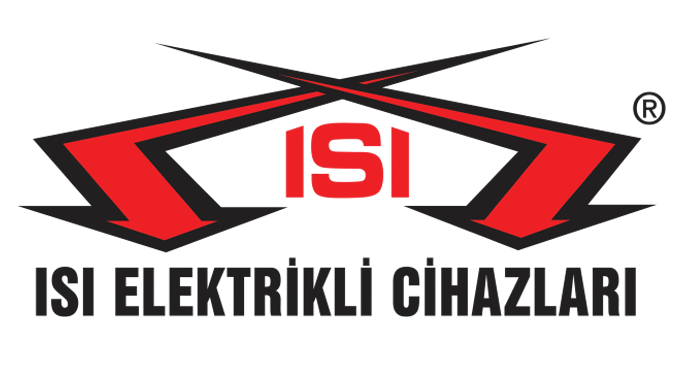
-min-500x500w.jpg)
-min-500x500w.jpg)
-min-500x500w.jpg)
-min-500x500w.jpg)
-min-500x500w.jpg)
-min-500x500w.jpg)
-min-500x500w.jpg)
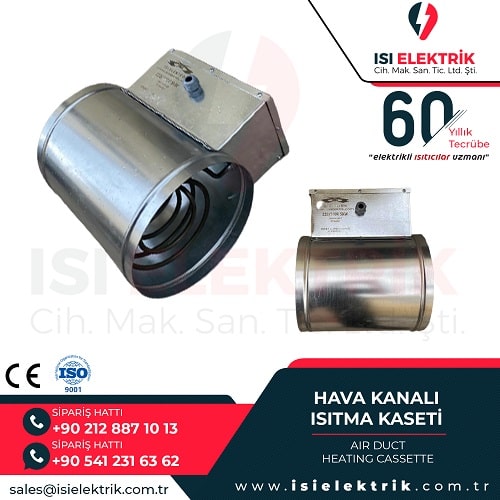
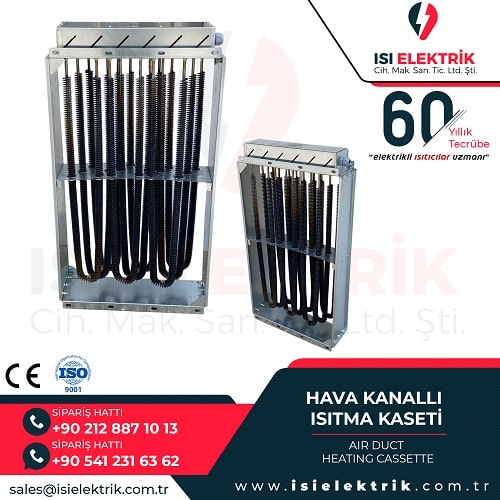
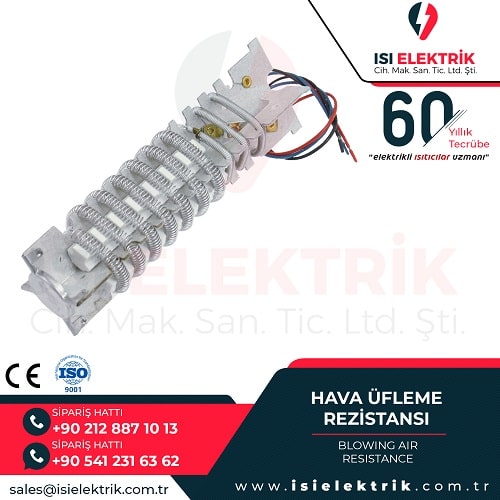
-min-500x500.jpg)
